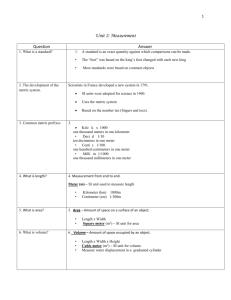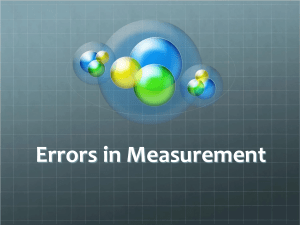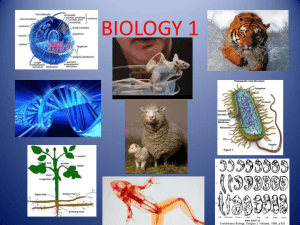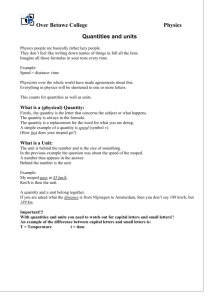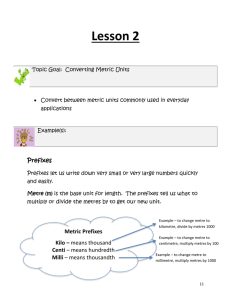12.MOTION AND MEASUREMENTS OF DISTANCES ORG
advertisement
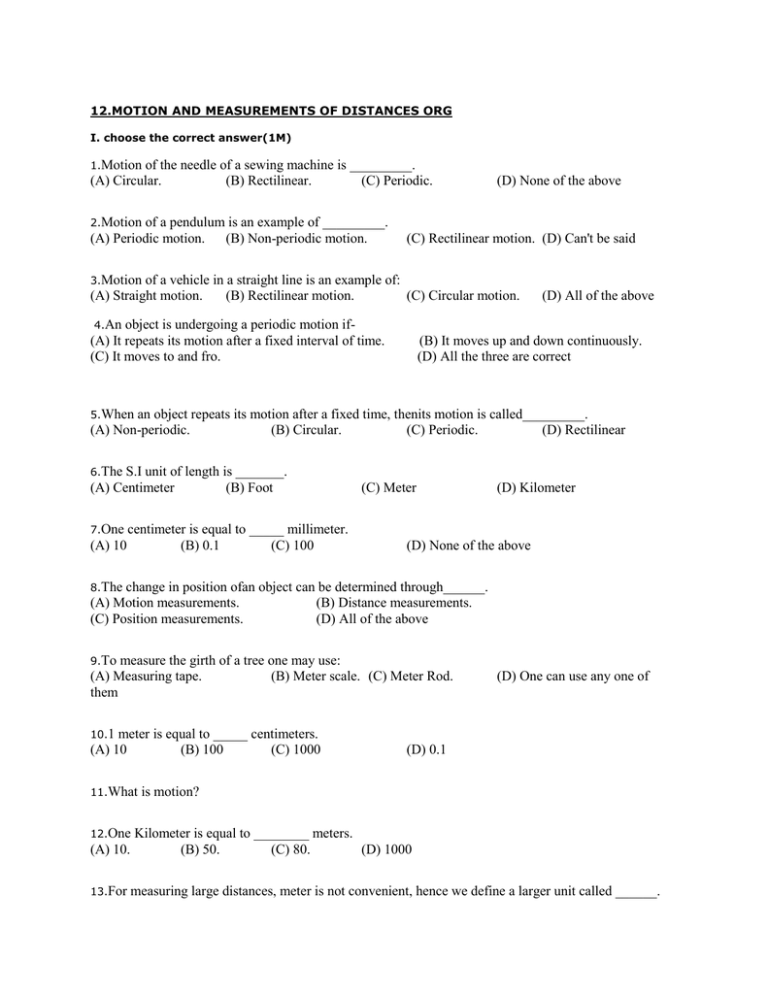
12.MOTION AND MEASUREMENTS OF DISTANCES ORG I. choose the correct answer(1M) 1.Motion of the needle of a sewing machine is _________. (A) Circular. (B) Rectilinear. (C) Periodic. (D) None of the above 2.Motion of a pendulum is an example of _________. (A) Periodic motion. (B) Non-periodic motion. (C) Rectilinear motion. (D) Can't be said 3.Motion of a vehicle in a straight line is an example of: (A) Straight motion. (B) Rectilinear motion. (C) Circular motion. 4.An object is undergoing a periodic motion if(A) It repeats its motion after a fixed interval of time. (C) It moves to and fro. (D) All of the above (B) It moves up and down continuously. (D) All the three are correct 5.When an object repeats its motion after a fixed time, thenits motion is called_________. (A) Non-periodic. (B) Circular. (C) Periodic. (D) Rectilinear 6.The S.I unit of length is _______. (A) Centimeter (B) Foot 7.One (A) 10 centimeter is equal to _____ millimeter. (B) 0.1 (C) 100 (C) Meter (D) Kilometer (D) None of the above 8.The change in position ofan object can be determined through______. (A) Motion measurements. (B) Distance measurements. (C) Position measurements. (D) All of the above 9.To measure the girth of a tree one may use: (A) Measuring tape. (B) Meter scale. (C) Meter Rod. them (D) One can use any one of 10.1 meter is equal to _____ centimeters. (A) 10 (B) 100 (C) 1000 11.What 12.One (A) 10. 13.For (D) 0.1 is motion? Kilometer is equal to ________ meters. (B) 50. (C) 80. (D) 1000 measuring large distances, meter is not convenient, hence we define a larger unit called ______. (A) Millimeter (B) Decimeter (C) Kilometer (D) Centimeter 14.An object is said to be in motion if: (A) Its position doesn't changes with time. (C) Both (a) and (b). (B) It doesn't move. (D) Its position changes with time 15.The position of eye should be _________ the scale to take the correct measurement of the object. (A) Anywhere on (B) Exactly in front of (C) Behind (D) At the top of 16.The S.I. system of measurement is the abbreviation of: (A) International system of units. (B) Standard of India. (C) System International. (D) All of the above are right 17.In 1790,______ created a standard unit of measurement. (A) Indians. (B) Romans. (C) Both (a) and (b) are correct. (D) French 18.The result of measurement is expressed in two parts one is ________ and the other is______ (A) Number, unit of measurement (B) Number (C) Unit, Unit (D) None of the above 19.Which of the following you may use to measure the length of a curved line. (A) Thread. (B) Scale. (C) Both (a) and (b). (D) None of the above 20.The known fixed quantity which is the measure of comparison with unknown quantity is called (A) Meter (B) Centimeter (C) Unit (D) All of the above 21.Measurement means the comparison of an _______ quantity with a ________ quantity. (A) Known, Unknown (B) Unknown, Known (C) Known, Known (D) Unknown, Unknown 22.Motion in a straight line is called: (A) Non periodic motion. (B) Periodic motion. (C) Circular motion. (D) Rectilinear motion 23.The distance between Amit's school and home is 4750 meter. The distance can be expressed in kilometer as: (A) 4.75 Km (B) 47.50 Km. (C) 0.475 Km. (D) 475.0 Km 24.Three kilometers is ______. (A) 3000 meters. (B) 2500 meters. 25.In (C) 2900 meters. (D) 3500 meters circular motion, an object moves in such a way that its distance from a fixed point remains ________. (A) Unequal (B) Non uniform (C) Same (D) All of the above 26.1 kilometer has greater magnitude than _________. (A) 10,000 meter. (B) 995 meter. 27.Refer (C) 9,999 meter. (D) None of the above to the figure shown below: The motion of the fan is(A) Circular (B) Rectilinear (C) Straight (D) All of the above 33.A ball is moving on the ground. The ball is undergoing (A) Rectilinear motion only. (B) Circular motion only. (C) Periodic motion only. (D) Rectilinear as well as rotational motion 34.Your scale is broken from one end at 1.5 cm. Youhave to measure the length of your Identity Card. (A) You will keep one end of the card at initial point and note the reading on the other end. (B) You will keep one end of the card at initial point and note the reading on the other end. You will add 1.5 cm to it to get correct measurement. (C) You will keep one end of the card at 2 cm and note the reading on the other end. You will subtract 2 cm from it to get correct measurement. (D) You will go to the market to buy a new scale and only then measure it 35.The height of a tree is 2.45 m. It is (A) 245 centimetre. (B) 245 millimetre. (C) 24.5 km. (D) 2.45 cm 36.Arrange the following in decreasing magnitude - 1 millimetre, 1 kilometre, 1 centimetre, 1 metre. (A) 1 millimetre, 1 kilometre, 1 centimetre, 1 metre. (B) 1 kilometre, 1 metre, 1 centimetre, 1 millimetre. (C) 1 millimetre, 1 centimetre, 1metre, 1 kilometre. (D) 1 kilometre, 1 centimetre, 1 metre, 1 centimetre 37.The invention of ________ revolutionized the transportation. (A) Bullock car. (B) Car. (C) Wheel. (D) Cycle 38.Invention of wheel made a great change in: (A) Modes of transport. (B) Sources of power. (C) Playing games. (D) Food habits (C) Playing game (D) Food habit 39.Invention of steam engine introduced a new: (A) Mode of transport. (B) Source of power. 40.March-past of soldiers in a parade is a kind of- (A) Circular Motion. (B) Rectilinear Motion. (C) Periodic Motion. (D) All of these 41.For our convenience, we take 1 metre = _______. (A) 100 centimetre. B) 0.001 kilometre. (C) 1000 millimetre. (D) All the three are correct 42.Set of standard units of measurement is known as: (A) International System of Units (SI units). (C) Measuring scale. (B) Standard scale. (D) Standards of India 43.Comparison of an unknown quantity with some known quantity is: (A) Estimation. (B) Observation. (C) Measurement. (D) Size 44.The unit of length used in ancient Egypt was: (A) A cubit as the length from the elbow to the middle finger tip. (B) Foot (C) Angul (D) Meter 45.Standard unit of measurement became necessary because: (A) Different sizes were compared to different body parts. (B) There is variation in sizes of body parts of different persons. (C) Both of these. (D) None of these 46.Selection of mode of transport to reach a place depends upon: (A) Your wish (B) Distance (C) Shape (D) None of these 47.The earliest mode of transport was: (A) Ship. (B) Railways. (C) Automobiles. (D) Animals 48.Length of a desk can be measured using: (A) Gilli Danda (B) Wicket and bails (C) String (D) All of the above (C) String (D) Standard scales 49.Exact length of an object is measured by using: (A) Gilli Danda (B) Wicket and bails 50.The fixed quantity used for comparing the size of other is called: (A) Length. (B) Unit. (C) Hand span. (D) None of these 51.SI unit of length is: (A) Metre. (B) Centimetre. (C) Kilometre. (D) Millimetre 52.The girth of a tree can be measured by using: (A) Metre scale. (B) Ruler. (C) Measuring tape. (D) Compass 53.If your scale has broken ends, then you should measure: (A) From the zero and then guess the correct distance. (B) Only after getting a new scale. (C) Using your fists and fingers. (D) Using any other full mark of the scale and subtract this reading from the reading at the other end II. Answer the following questions.(1M) 1.What do you mean by the term "year"? 2.Name the unit of length that you may use to measure distance between Kolkata and Patna. 3.What is measurement? 4.What is unit? 5.Give example of an object which moves in a circle? 6.What is the unit of length in S.I unit. III. Answer the following questions.(2M) 55.Name 56.Give two devices that are used to measure length. two examples of mode of transport, used on land? 57.While measuring the length of a knitting needle, the reading of the scale at one end is 3.0 cm and on the other end is 33.1 cm. What is the length of needle? 58.The height of a person is 1.65 m. Express it into cm and mm. 59.Give two examples of a periodic motion. 60.Identify all types of motions in a) sewing machine at work. b) rolling ball. 61.Why was the discovery of wheel considered as a great achievement? 62.What is the need for standard units ? 63.Why did scientist introduce SI units? 64.Why precautions should be taken while measuring length? IV. Answer the following questions.(3M) 65.Give an example for following types of motion: 1. Linear Motion. 2. Circular Motion. 3. Rotatory Motion. 66.Classify the following into different types of motion: a) The motion of man on a straight road. b) The motion of wheels of a car. c) The motion of a falling stone. 67.Describe three rules to measure length. 68.Give at least 3 occasions where we come across a need to measure lengths & distances 69.What are the various ways to measure the length of a table? 70.What is meant by measurement? How is the result of measurement expresses? Give examples. 71.Why can't a pace or a foot step be used as a standard unit of length? What was done to avoid this? 72.What is meant by motion? How would you decide if a body is at rest or in motion? 73.The distance between Ritu's home and her school in 3250 m. Express the distance into km? 74.While measuring the length of a knitting needle, the reading of the scale at one end is 3.0 cm and at the other end is 33.1cm. What is the length of the needle? 75.How many millimeters are there in a) 23cm b) 13cm : c) 7cm d) 2 cm e) 1 cm 76.How many meters are there in : a) 230 cm b) 770 cm c) 830 cm V. Answer the following questions.(1M) 77.Describe a method for measuring the length 78.Mention d)990 cm e) 800 cm of a curved line? and explain about any 2 types of motions, with 2 examples each? 79.What were the various units or lengths used in ancient times? Who used them? 80.Name two modes of transport of ancient times and two modes of transport of modern times? 81.With the help of pencil of geometry box, Find the length and breadth of your desk? 82.A cubit and a foot cannot be used a s standard unit. Why? 83.Write a relation connecting meter with centimeter and kilometer with meter ?


